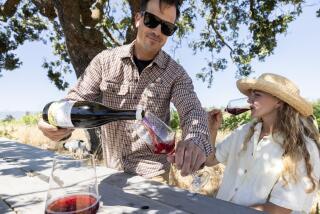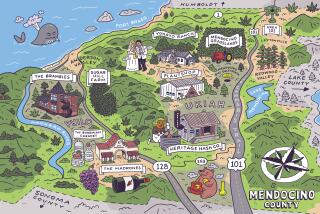Vintage Seaver
CALISTOGA, CALIF. — Amid the vibrant green of the sun-splashed vineyard, surrounded by a forest of redwood, Douglas fir, manzanita, tanbark oak and madrone, it is difficult to tell whether the bounding Brandy, a black lab, or its master is more content.
The dog’s gleeful gait expresses what its master verbalizes.
For the record:
12:00 a.m. July 7, 2007 For The Record
Los Angeles Times Saturday July 07, 2007 Home Edition Main News Part A Page 2 National Desk 1 inches; 47 words Type of Material: Correction
Vineyards: In a chart in Thursday’s Sports section listing some famous sports figures who have vineyards, the location of John Madden’s property and Peggy Fleming’s was given as Napa Valley. Madden’s vineyard is in Livermore Valley, and Fleming’s is in Los Gatos in the Santa Cruz Mountains.
“If I had a dream,” Tom Seaver says, “it couldn’t get any better than this.”
At 62, in jeans and work shirt with pruning shears on his belt and a John Deere backhoe in the tool shed, the Hall of Fame pitcher has found peace and passion on Diamond Mountain, 800 feet above the fertile Napa Valley and its ever-expanding string of wineries, some large and some small.
The Seaver vineyard is among the smallest. He is growing cabernet (sauvignon) grapes on 3 1/2 acres of his 115-acre maze of bush, trees and spectacular vistas.
Each morning, as the sun summons him to another work day in the vineyard, Seaver tends to shake his head at the good fortune that enabled him to find this bit of heaven.
“I’ve always said that I’d rather be lucky than good,” he says. “It’s like when you hang a slider with runners in scoring position and the batter pops it up and everyone says to you, ‘That was a great pitch in that situation,’ and you kind of laugh to yourself knowing the truth.”
The truth is that perseverance and vision -- and luck -- were major factors in Seaver and his wife Nancy locating this acreage on Diamond Mountain (named long before the baseball man arrived) and imagining what it could become.
Now, having recently bottled his first wine under the GTS (George Thomas Seaver) Vineyard label and preparing to sell by mail, Seaver is experiencing the same creative vibes that he did on the mound, a mental and physical craftsman who came out of USC to win 311 games, strike out 3,640 batters, receive three Cy Young Awards and be voted into the Hall of Fame in 1992 with a first-ballot percentage of 98.84 , still the record.
How often did a manager come to the mound with runners on base and the game on the line, he recalled, and ask him what pitch he intended to throw, only to have Seaver respond, “I made that decision yesterday.”
“In many ways,” he said, “what we are doing now in growing grapes is similar to what I did when pitching -- the organization, the attention to detail between starts.
“In many ways there is a sequential rhythm and analogous nature to the two seasons, and I’m sure that was a large part of the attraction for me.”
It was 30 years ago that the pitcher referred to as “The Franchise” was traded by the New York Mets to the Cincinnati Reds for Pat Zachry, Doug Flynn and Steve Henderson in a deal that stunned the Big Apple and stemmed from what had become a bitter and divisive relationship with Mets Chairman M. Donald Grant.
As the Mets faltered in the wake of the 1977 trade, Seaver, who had won 25 games in pitching the amazing Mets to a World Series title in 1969 and 19 more in the 1973 pennant season, went on to continued success with the Reds and Chicago White Sox before ending his career with Boston in 1986.
Looking back from Diamond Mountain, his severed ties to the Mets having taken years to heal (he ultimately returned as a team broadcaster for six years starting in 1999 and still does periodic promotional work), Seaver said that the trade represented both his “worst and best day.”
He said that while it would have been great to spend his entire career with the Mets, he couldn’t be sure that he would have gone on to win 300 games considering the way Grant was tearing the team apart, and “the bottom line is that I’ll always be grateful to have experienced everything I did.”
It also was some 30 years ago, with Seaver still in his pitching prime, that a brother-in-law asked what he intended to do when he retired.
“I told him that I intended to go back to California and grow grapes,” he said. “It just kind of emerged from the back of my mind and I think there was an amalgam of reasons.”
Seaver had grown up around agriculture, his father having been in the raisin business in Fresno, and he had begun sampling wines, enjoying the experience, at USC, an education that he and Nancy expanded during several off-season bicycle trips through the wine regions of France.
The more Seaver read and explored the process of growing grapes and producing wine, the more he unearthed the similarities between the seasons, the more he began to envision a vineyard in his future.
“Nancy would ask me if I was sure I would like it,” Seaver said, “and I would tell her, ‘No, but I know there’s an itch.’ I also knew that whatever I eventually did there had to be a physical involvement. Look at my [scarred] fingers and [dirtied] nails. I call it the red badge of courage. For me, sitting in front of a computer would be instant death. Nancy has the computer. I don’t.”
For 30 years the Seavers lived in a renovated barn in Greenwich, Conn., delaying their return to California and a search for a potential vineyard until daughters Sarah and Anne had finished Boston College.
Ultimately, that two-year search took them through San Luis Obispo, Apple Valley, Mendocino, Paso Robles and even into Oregon. When they stopped at a Realtor’s office in the small Napa Valley community of St. Helena, one of the sale clips they were given was for the parcel on Diamond Mountain.
“I suspect that other potential buyers had been here before and never got out of their car,” Seaver said. “I was in the Marines. Sometimes you have to put boots on the ground. This was the classic case of needing to see the forest through the trees.”
With clippers in hand, Seaver clipped and slashed through enough foliage to get a glimpse of the possibility: Mount St. Helena and the Palisades range across the valley, the Sterling Winery and Three Palms Vineyard below.
It was 1998, and the Seavers had found a site for their new home.
Clearing only where need be, Boston architect Kenneth Kao would design a 7,000-square-foot house that blends into the hillside, beige walls merging with the soil and the curves and color of the copper roof copying the curves and color of the surrounding hills and trees, the patio and pool area taking advantage of the panoramic view.
It was 2000 when the Seavers moved in, and he began planning the vineyard below his office window. Nancy had other thoughts. They had 115 acres, and she preferred that the trucks and other farm equipment be out of sight. Besides, she had a greenhouse and rose garden to create, now a colorful addition to the panorama.
Armed with a compass, Seaver began cutting and slashing through the foliage again and found, to his delight, a pair of tree-covered slopes facing south and southeast. He knew from research that the best grapes grow with southern exposure, and vineyard manager Jim Barbour, recommended to him by former teammate and restaurant owner Rusty Staub, underscored that, telling Seaver, “How in the world did you find it? This is what people are killing for out here.”
Well, Seaver said, “Sometimes you win, 7-6. That’s what I mean about being lucky.”
Seaver has 3,980 plants, coming up to his sixth harvest. The first three years, he said, “The fruit is simply cut away because you want all the energy going into the root system.”
The ’06 harvest is in French oak barrels under the auspices of winemaker Thomas Brown. The ’05 was bottled June 5 and will be ready to be shipped next spring. The first vintage will produce about 450 cases, 5,400 bottles. Seaver is preparing a mailing list of potential buyers (GTS Vineyards, Box 888, Calistoga, CA 94515) and has no desire to get bigger. Nor will he say how much he has invested on Diamond Mountain.
“We’re close, in year six, to a return on capital,” he said. “My game plan is to break even in 10 years, and we may beat that by a year.
“We’re a drop in the bucket [compared to other wineries], but I’m talking quality and not quantity. It’s Diamond Mountain cabernet, south-facing slope. It has the potential to be drop-dead stuff.”
There will certainly be a cult aspect to the initial offering simply because of the name, although Seaver said he wasn’t doing this “to get my face on the cover of Wine Spectator because I’ve had enough of all that” and initially had no desire to have his name or even initials on the label. He wanted the wine to stand on its own merits, he said, but his daughters reminded him that no one lives forever, that his grandchildren might be operating the vineyard one day, and that his name had to be on it.
Now, the back of the label will read, “May you enjoy this wine as much as I enjoy the journey bringing it to you. Day to day, month to month, season to season.”
On those nights when Sandy Koufax or Bob Gibson or Steve Carlton or Don Baylor have journeyed to Diamond Mountain, enjoying a glass of wine, warmed by the camaraderie and outdoor fire pit, awed by the vista, aware of the sense of time, as Seaver puts it, that “seems to radiate here,” what could be better in any season or any place?
--
(BEGIN TEXT OF INFOBOX)
Pouring it on
Tom Seaver isn’t the only sports figure to own a vineyard and work in the wine industry. A look at a few of the others:
Mario Andretti
Sport: Auto racing. Location: Napa Valley
* Andretti said that when he sees his wine being tasted for the first time he gets a rush similar to that of racing.
Peggy Fleming
Sport: Figure skating. Location: Napa Valley
* All of the proceeds from the vineyard’s “Victories Rose” go to breast cancer research.
John Madden
Sport: Football. Location: Napa Valley
* The coach-turned-broadcaster has 150 acres around his Livermore Valley home set aside for grape growing.
Greg Norman
Sport: Golf. Location: Napa Valley.
* The Shark has vineyards in Australia and California.
Dick Vermeil
Sport: Football. Location: Napa Valley.
* The Calistoga native began producing wine with OnThEdge Winery when he was retired for a time.
-- JAIME CARDENAS
More to Read
Eat your way across L.A.
Get our weekly Tasting Notes newsletter for reviews, news and more.
You may occasionally receive promotional content from the Los Angeles Times.









